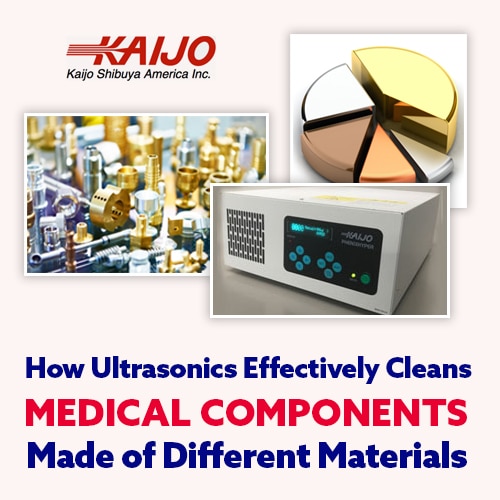How Ultrasonics Effectively Clean Medical Components Made of Different Materials
February 7, 2023
 When medical components are cleaned using ultrasonics, the ultrasonic frequency of the cleaning system needs to be chosen carefully. Using the right ultrasonic frequency depends on the materials that make up the medical device. Higher frequencies deliver gentle cleaning action for soft or coated materials, and low frequencies provide rapid removal of heavy contamination on hard surfaces. Some contaminants are removed more quickly when the cleaning solution is heated or when a mild solvent is added. An experienced manufacturer of medical ultrasonic cleaners can help select the best cleaner for a specific medical application and ensure the cleaning performance meets expectations.
When medical components are cleaned using ultrasonics, the ultrasonic frequency of the cleaning system needs to be chosen carefully. Using the right ultrasonic frequency depends on the materials that make up the medical device. Higher frequencies deliver gentle cleaning action for soft or coated materials, and low frequencies provide rapid removal of heavy contamination on hard surfaces. Some contaminants are removed more quickly when the cleaning solution is heated or when a mild solvent is added. An experienced manufacturer of medical ultrasonic cleaners can help select the best cleaner for a specific medical application and ensure the cleaning performance meets expectations.
Medical Devices Made of Different Metals Can Be Cleaned at Low Frequencies
Medical components such as hip or knee replacements are made of different metals and alloys. Typical materials include stainless steel or titanium and nickel-titanium or cobalt-chrome alloys. Such metals have the high strength and hardness required for the joints they replace, and their hard surfaces make them suitable for rapid cleaning at low ultrasonic frequencies.
An all-purpose ultrasonic cleaner for industrial cleaning will use a low-end frequency range of 20kHz to 40 kHz. The metal joint replacements can be cleaned before use, ensuring that no foreign matter is introduced into the surgery site. The parts will be sterilized if a disinfectant is added to the cleaning solution.
Mixed Material Parts Need Special Consideration
Many implantable medical devices contain metals, plastics and ceramics. Determining which ultrasonic frequency best cleans the parts while avoiding damage can be challenging. Sometimes soft metals such as aluminum are used and the plastics can be relatively hard or very soft.
Typically a higher frequency, such as at least 78 kHz, will be needed. Sometimes a test of the different materials at various frequencies can determine the optimal solution. The 78 kHz frequency avoids surface pitting for many common materials that are softer than hard metals. Kaijo’s Water Resonance System can also add agitation to the bath to speed up the cleaning process.
Medical Devices with Coatings Require Gentle Cleaning
Optical parts of medical devices often have coatings on lenses, and other parts may also have delicate coatings. Such coatings are easily damaged if the ultrasonic frequency used for cleaning is too low. A frequency as high as 430 kHz may be needed to successfully clean coated lenses without damaging the surface. Optical devices for internal medical diagnosis can be cleaned and sterilized in a high-frequency ultrasonic bath with a disinfectant. The high ultrasonic frequency delivers gentle cleaning to remove light contamination while the disinfectant sterilizes.
Delicate Electronics May Require the Highest Cleaning Frequencies
Electronic sensors and diagnostic devices often have very sensitive diaphragms or sensing surfaces that are both soft and fragile. An ultrasonic cleaning frequency of 950 kHz will gently clean delicate surfaces. Using a high frequency ensures that even the softest materials do not suffer pitting and delicate structures are not damaged.
Using the Right Frequency Delivers Excellent Cleaning Performance
While it may be difficult to select an ultrasonic cleaner that can handle the cleaning requirements of many different medical devices, once the right cleaner and frequency are set up, cleaning becomes easy. Medical ultrasonic cleaners clean quickly and entirely without manual cleaning before or afterward. Time saved can be substantial, and medical devices are cleaner than using traditional cleaning methods.
Kaijo Provides Expert Guidance in Selecting the Right System for Your Application
Kaijo has extensive experience with ultrasonic cleaning technology and provides medical ultrasonic cleaners that are versatile and can be customized. In addition, Kaijo helps customers select the right cleaner, frequency, and configuration for their specific medical application. Once the ultrasonic cleaner is configured correctly, Kaijo can ensure it delivers superior cleaning performance to meet a customer’s cleaning requirements.





